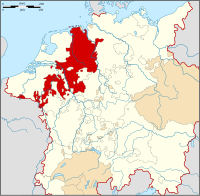County of Ravensberg
County of Ravensberg Grafschaft Ravensberg | |||||||||
|---|---|---|---|---|---|---|---|---|---|
| 1140s – 1807 | |||||||||
 Map of part of the Lower Rhenish–Westphalian Circle in 1560, County of Ravensberg highlighted in red | |||||||||
| Status | State of the Holy Roman Empire (until 1806) | ||||||||
| Capital | Bielefeld | ||||||||
| Government | Principality | ||||||||
| Counts | |||||||||
| Historical era | Middle Ages | ||||||||
• Otto I, Count of Ravensberg | 1140s 1140s | ||||||||
| 1338 | |||||||||
| 1500 | |||||||||
| 1521 | |||||||||
| 1614 | |||||||||
• Disestablished | 1807 | ||||||||
| |||||||||
The County of Ravensberg (Template:Lang-de) was a historical county of the Holy Roman Empire. Its territory was in present-day eastern Westphalia, Germany at the foot of the Osning or Teutoburg Forest.
History


Ravensberg was first mentioned in the 12th century; its first capital was Burg Ravensberg. The Counts of Ravensberg then had Sparrenberg Castle built in Bielefeld ca. 1240–50, which they made their seat.
The county was later inherited by the Duchy of Berg in 1346, which in turn became part of the Duchy of Jülich-Berg in 1423, and ultimately the United Duchies of Jülich-Cleves-Berg in 1521.
After the War of the Jülich succession, in the Treaty of Xanten in 1614, the County of Ravensberg came to the Margraviate of Brandenburg, which became the Kingdom of Prussia in 1701, and was administered within Minden-Ravensberg from 1719–1807, when it was dissolved during the Napoleonic Wars.
Aside from Bielefeld, other communities in the County of Ravensberg were Borgholzhausen, Halle, Steinhagen, Versmold, Werther, Isselhorst (now part of Gütersloh), Enger, Hiddenhausen, Rödinghausen, Spenge, Herford (except for Falkendiek), Bünde (except for Dünne and Spradow), Vlotho (except for Uffeln), Kirchlengern south of the Werre, Preußisch Oldendorf (except for Hedem and Lashorst) and Bad Oeynhausen south of the Werre.
See also
External links
![]() Media related to County of Ravensberg at Wikimedia Commons
Media related to County of Ravensberg at Wikimedia Commons


